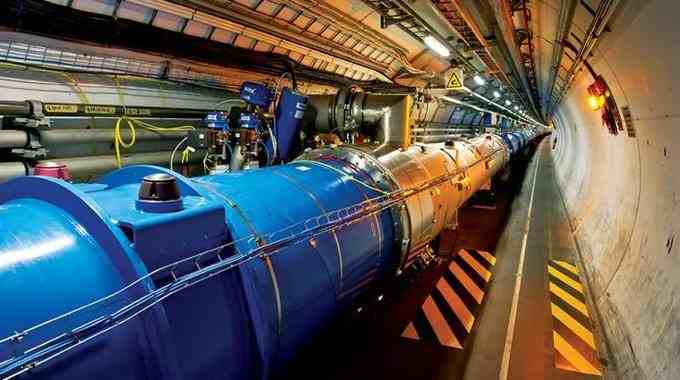AT 27 KILOMETERS long, it’s the biggest machine on the planet. The most distinctive feature of the Large Hadron Collider is its temperature.
The SSC’s partly finished tunnel, near Waxahachie, Texas, now lies derelict – killed by a ballooning budget and a shortage of initiation.
It was a conclusion that resulted in a carefully choreographed dance of extreme engineering. Subterranean rivers were frozen in superconductors, parts sent around the world and mid flow.Among the tasks planned for the SSC ring was to look for the Higgs boson, the particle by which the universe is believed to get its mass.
To get the particles going at such energies in a ring needs directing so exact that extreme magnetic fields can just provide it. These work without loss of electricity when cooled below a critical temperature. The SSC hadn’t shoved the technological bounds, though, choosing superconducting magnets cooled by liquid helium to a comparatively tepid 4.5 K, which were already being used in other accelerators.
For a specified radius of tunnel, the more dynamic the particles, the more strong the magnets should be. Since the magnets of the SSC weren’t strong enough, the tunnel had to be 87 kilometers round. The SSC was doomed by the price of constructing a machine this large.Concerned not to make precisely the same error, the engineers of LHC had to be fearless. The LHC was aiming for increase – folds. It needed the next generation of superconducting coils for the strong magnets needed to turn its high energy proton beams around the tight curve of the tunnel, and for the radiofrequency pits used to accelerate protons.
The magnets and the RF cavities had to be compact enough to fit into the little-bore tunnel, while carrying exceptionally high currents.
This, however, came at a cost. At that temperature, liquid helium becomes superfluid, with quantum properties that are unusual.
This means it can slip through microscopic cracks and has zero viscosity. The thousands upon thousands of welds in the pipes had to be.
By the late 1990s, the most pressing problem was the huge cavern -tonne sensor that may monitor the particles that fly out from the wrecks. One of the most significant of these heavier variations of the means to quantify their momentum, and electrons will be to deflect their courses in a magnetic field.
Due to the power of the LHC, these muons will be faster moving than anything seen in previous colliders and livelier, so the magnetic fields need to be really powerful. The more powerful the field, the more the particles turn, and the more exactly their properties can be quantified.
ATLAS ended up by volume, with the world’s largest superconducting magnet. The cavern created to place this 12-storey-high behemoth had to be 35 meters high. It is so large that the hydrostatic pressure of the cavern causes it to rise somewhat like a bubble in water, albeit extremely slowly.
“It goes about 0.2 millimeters up every year,” says ATLAS spokesman Peter Jenni, so the flooring had to be project 5 meters thick to ensure that it does not warp as it grows.
It’s thrown up its own share of challenges.
The consequences can somewhat interrupt the course of other protons as they race around the ring as protons collide inside the sensors. The sensors need to be far away from each other as potential to minimize this effect. So the CMS has been sited opposite ATLAS, which places it at the foundation of the Jura Mountains.
This meant trouble.
“It was the worst possible location from a civil engineering viewpoint,” says project engineer John Osborne. “The conditions were awful.”
The engineers had to excavate on two 60-metre-deep shafts, one for one and lifts to lower the sensor.When they got there, they discovered the region consisted so they borrowed a technique from the mining sector referred to as soil-freezing. Miners seldom must compete with the swift-moving water located at the CMS website, however. The workers drilled holes along the periphery of the shafts into which they buried 60-metre conduits.Subsequently, for a month, the pipes filled with liquid nitrogen at -196 °C. This created a 3-metre-thick retaining wall of ice that kept the groundwater at bay, while the dry earth was excavated by the workers within and built the rotating shafts.
The CMS team determined to outdo ATLAS when it constructed one twice as powerful and came to the power of its magnetic field. Crucial to its 10,000-tonne magnet are superconducting coils designed to resist an outward force of 60 atmospheres produced by field – about 100,000 times more powerful than Earth’s magnetic field. On the other hand, the technology was so advanced and changed that no one firm, or state, could do the job. So the coils of the magnet were shunted around Europe on a journey that began in Finland and took in Italy, France and Switzerland en route to CERN.
“The coil was examined in 2006, and it worked flawlessly.”
“The technology was so advanced and changed that no one firm, or state, could do the job.”
It’s critical the whole LHC and its detectors operate from the word go, as after the system is up and running fixing them will be far from insignificant.
“It is like being in outer space,” says Evans. “If anything bad happens, you can not only go in there and touch it.”
It’d need to be permitted to warm back up to room temperature, which takes, to fix the LHC, for example.
Unsurprisingly the engineers have done their bit. Now it is the scientists’ move.
“I am truly looking forward to the the next couple of months, and to see the physics coming out,” says Evans.
Vladislav Kogan is a travel blogger from Australia who is also interested in Pureairfil services



